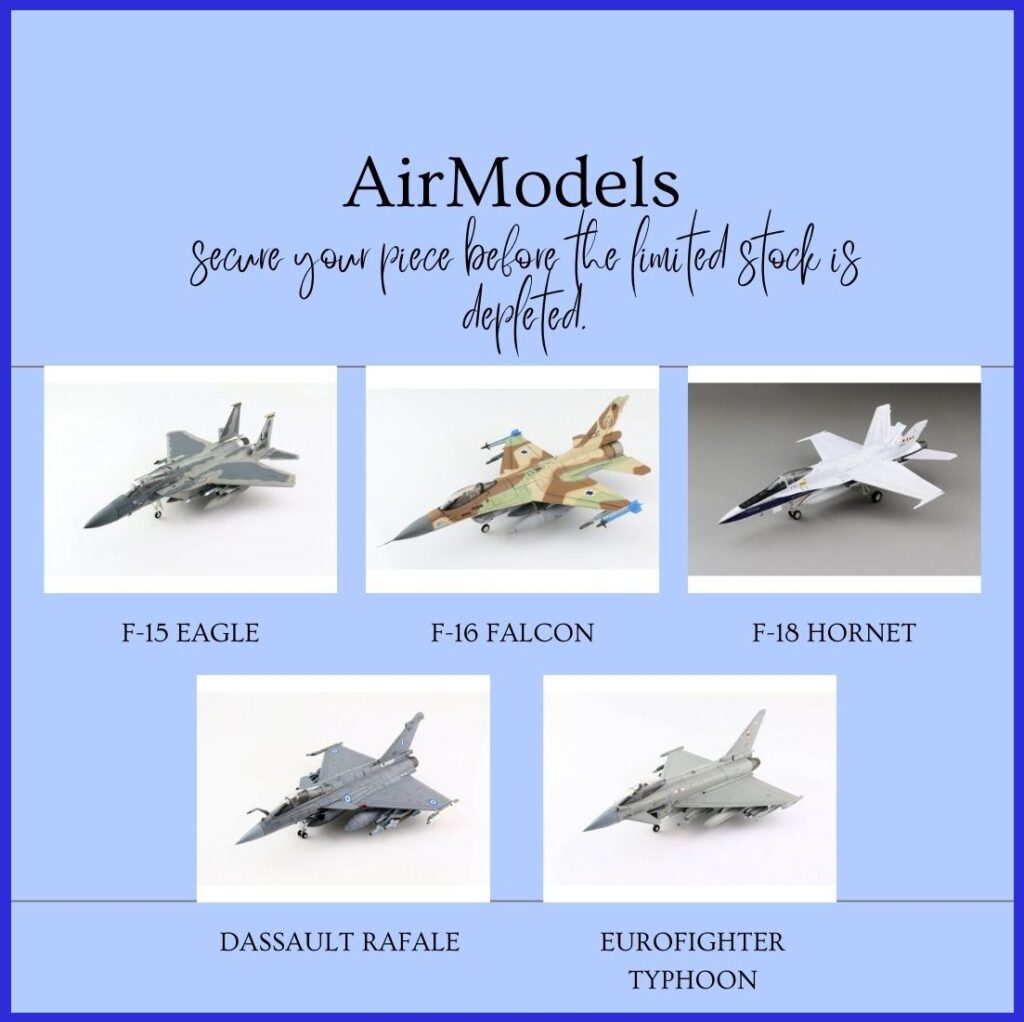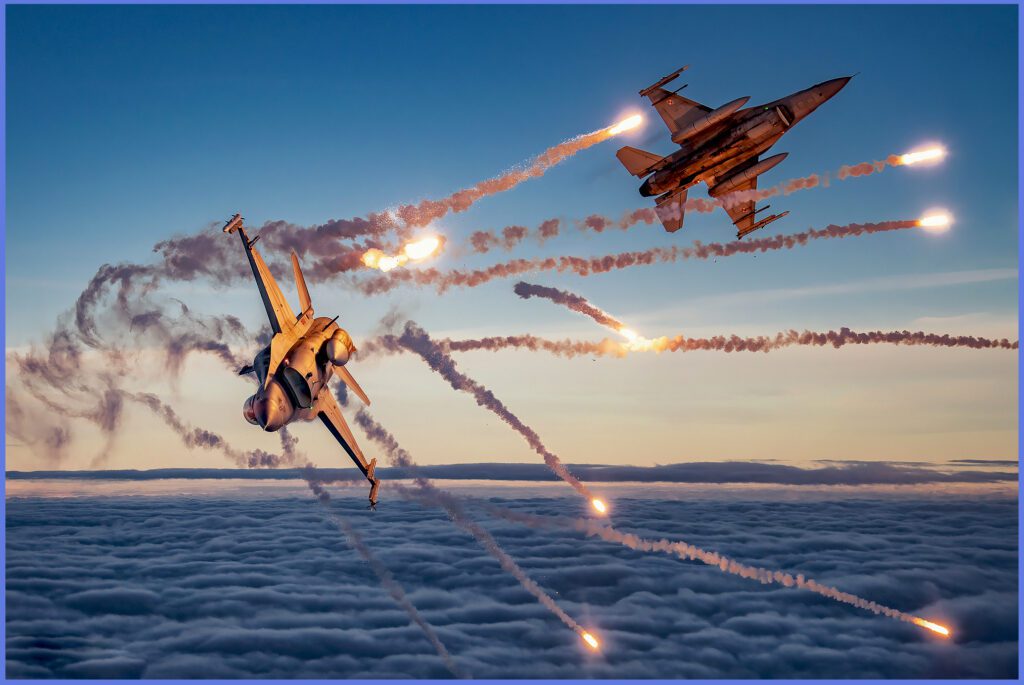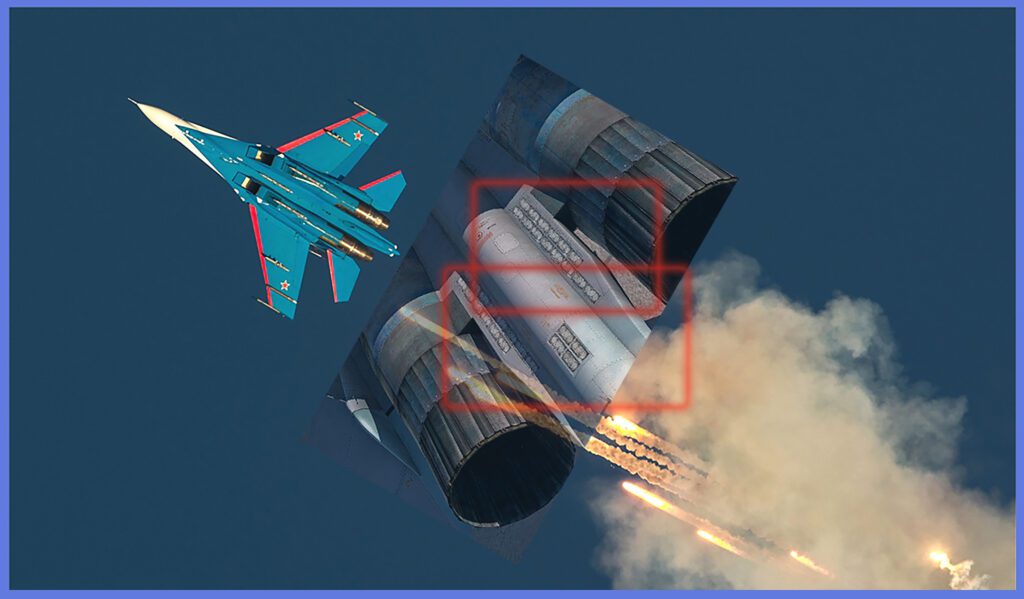The concept of using chaff developed during World War II as an independent creation, initially in the United Kingdom and Germany and subsequently in the United States and Japan, each developing it to meet their requirements.
Let’s Discover the Best of Chaff and Flare in Aerial Defence, which came into massive effect following the origins of radar-homing and infrared-homing missiles. In the 21st century, this technique is paramount in countering any incoming missiles’ final stage.

The First Idea/Origin of Chaff During WWII
During World War II, Chaff, also known as “Window,” emerged as a countermeasure against enemy radar. British researchers in 1937, including Gerald Touch, Robert Watson-Watt, and R. V. Jones, proposed the idea of using lengths of wire suspended from balloons or parachutes to overwhelm radar systems with false echoes. Subsequently, they considered using pieces of metal foil falling through the air for the same purpose.
In early 1942, Joan Curran, a researcher at the Telecommunications Research Establishment (TRE), further investigated this concept. She developed a plan to release packets of aluminium strips from aircraft to create a cloud of false echoes, confusing enemy detection systems.

One early concept involved using sheets the size of notebook pages, which could also double as propaganda leaflets when printed. However, it was discovered that the most effective version consisted of strips of black paper backed with aluminium foil, packed into bundles weighing 1 pound each.
A.P. Rowe, the head of the Telecommunications Research Establishment (TRE), gave the device the code name “Window.” Meanwhile, in Germany, similar research led to the development of Düppel.
This German code name originated from the estate where the first German tests with chaff occurred around 1942. Eventually, the British shared the concept with the United States through the Tizard Mission.

The systems utilized small aluminium strips (or wires) cut to half the wavelength of the target radar, causing them to resonate and re-radiate radar waves. This made it challenging for opposing defences to differentiate between the aircraft and the chaff echoes.
Discovered by Joan Curran in Britain in 1942, chaff was also independently developed in the United States by astronomer Fred Whipple and Navy engineer Merwyn Bly. Whipple presented the idea to the collaborating Air Force. In the Pacific Theatre, Japanese Navy Lieutenant Commander Sudo Hajime invented a Japanese version called Giman-shi, or “deceiving paper.”

Decoy Dominion: Chaff Countermeasures in Modern Warfare
Chaff, formerly known as ‘Window’ in its early days, is a radar countermeasure utilized to confuse and disrupt enemy radar systems. It comprises small, lightweight strips or particles of aluminium-coated material, metallized glass fibre, or plastic released into the air from aircraft or ground-based platforms.
Upon deployment, dispersed chaff produces a large radar cross-section intended to blind or disrupt radar systems, creating false targets and obscuring the actual location and identity of aircraft or military assets.
Originally developed during World War II, chaff became a crucial defensive tool for Allied forces, particularly in strategic bombing campaigns. Modern military forces use chaff to distract active radar-homing missiles from their targets.
By generating a cloud of radar reflections, chaff can effectively deceive enemy radar-guided weapons and tracking systems, thereby increasing the survivability of aircraft and reducing the accuracy of enemy targeting.

Ballistic missiles are also designed to release chaff during their midcourse phase, along with other penetration aids. Modern chaff systems have evolved to include advanced materials and deployment techniques, enhancing their effectiveness against sophisticated radar systems.
Military aircraft and warships are mostly equipped with chaff dispensing systems for self-defence. Chaff remains an essential component of electronic warfare strategies, providing valuable protection for military assets operating in contested airspace.
Chaff countermeasures are divided into two primary types: continuous wave (CW) chaff, employed against radar-guided missiles operating on a continuous frequency, and pulsed chaff, utilized against missiles operating on a pulsed frequency. Modern chaff systems are engineered to stay airborne for extended periods.
They are stored in tubular cartridges that remain affixed to the aircraft, with each cartridge typically containing approximately 3 to 5 million chaff fibres. The ejection of chaff from the cartridge is achieved by a plastic piston driven by a small pyrotechnic charge.

Flare Dynamics: Unveiling the Power of Flare Countermeasures
Flare countermeasures are defensive measures employed by military aircraft and vehicles to evade heat-seeking missiles. These countermeasures typically involve the deployment of pyrotechnic flares that emit intense heat and light, diverting the attention of infrared-guided missiles away from the targeted aircraft.

When an aircraft detects an incoming heat-seeking missile threat, it deploys flares, which ignite rapidly upon exposure to air. The intense heat and bright light emitted by the flares create a decoy target, diverting the missile away from the aircraft and allowing it to evade destruction.
Flares commonly consist of a pyrotechnic composition based on materials such as magnesium or other hot-burning metals, with a burning temperature equal to or higher than engine exhaust. The objective is to lure the infrared-guided missile towards the heat signature from the flare rather than the aircraft’s engines.

Flare countermeasures are highly effective against infrared-guided surface-to-air missiles or air-to-air missiles, which home in on the heat emitted by aircraft engines or other hot surfaces.
They are a critical component of aircraft survivability systems, providing a means of self-defence against infrared-guided threats encountered in combat situations. Modern flare systems may also incorporate advanced electronic sensors and dispensing mechanisms to optimize their effectiveness and enhance aircraft survivability.

Materials Used in Flares and Their Decoying Process
Flares typically consist of a casing containing a pyrotechnic and pyrophoric composition, which produces intense heat and light upon ignition. The composition usually includes a mixture of oxidizers, fuels, and binders, such as potassium perchlorate, sulfur, charcoal, and polymeric materials. These ingredients burn rapidly and emit high temperatures, creating a bright infrared signature that diverts heat-seeking missiles away from the aircraft.
In addition to the pyrotechnic composition, modern flares may also incorporate special additives or coatings to enhance their effectiveness. For example, some flares contain compounds that generate smoke or aerosols, further confusing missile guidance systems by creating additional visual interference. There is a wide variety of calibers and shapes available for aerial decoy flares, based on the type and aerodynamics of the aircraft.

The Decoying Process of Flares involves the aircraft deploying them in response to an incoming heat-seeking missile threat. Once released, the flares ignite, burning at thousands of degrees Celsius and producing a sudden burst of intense heat and light. This emission serves as a decoy target, diverting the missile’s guidance system away from the aircraft’s actual heat sources, such as engines or exhausts.
As modern infrared seekers become more advanced, with spectral sensitivity tailored to closely match airplane emissions and reject other sources (known as CCM or counter-countermeasures), modernized decoy flares optimize their emission spectrum to also match the radiation of the airplane, mainly its engine exhaust.
Besides spectral discrimination, CCMs may involve trajectory discrimination and detection of the size of the radiation source. Overall, flares, by drawing the missile toward the flare’s heat signature, effectively disrupt the missile’s tracking and targeting, allowing the aircraft to evade destruction.

What distinguishes chaff from flares?
Chaff and flares are defensive countermeasures used by military aircraft, serving different purposes and operating on distinct principles.
Chaff consists of small, lightweight strips or particles of aluminium-coated glass fibre material released into the air to confuse and disrupt enemy radar systems. It reflects radar signals, creating false targets and obscuring the actual location and identity of the aircraft or military assets. Chaff is effective against radar-guided missiles and tracking systems.

Flares are pyrotechnic devices deployed to evade heat-seeking missiles. When an aircraft detects an incoming heat-seeking missile threat, it releases flares, emitting intense heat and light to divert infrared-guided missiles away from the targeted aircraft. Flares serve as decoy targets, drawing missiles away from the aircraft’s heat sources, such as engines or exhausts.
In summary, chaff confuses radar systems, while flares distract infrared-guided missiles, providing aircraft with two distinct defensive capabilities against different types of threats.
